Submitted by Berrin Chatzi Chousein
"In the end it is very difficult to avoid from the notion of style" says Benedetta Tagliabue
Spain Architecture News - Jul 25, 2019 - 00:25 9984 views
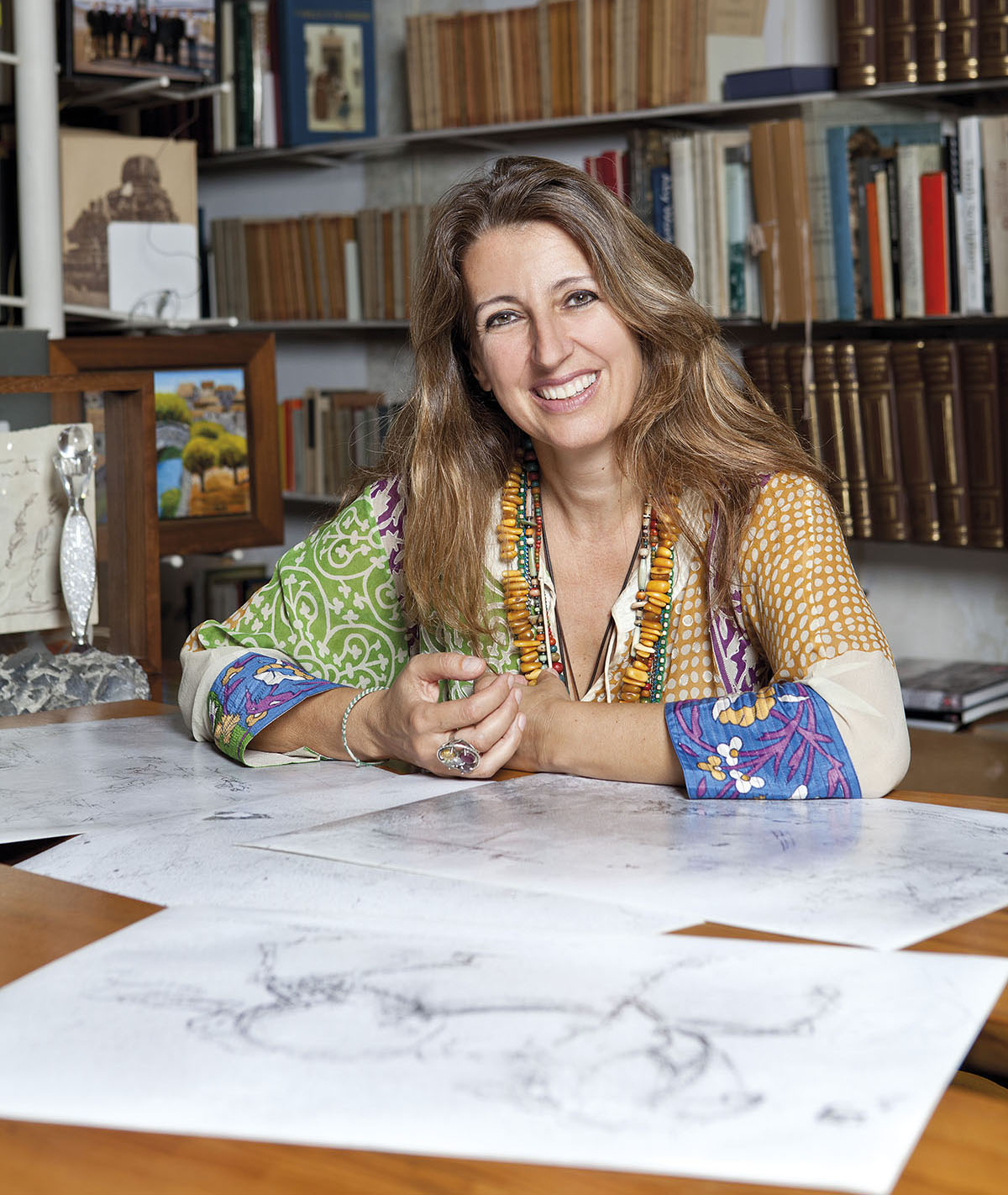
"In the end it is very difficult to avoid from the notion of style," according to Italian architect Benedetta Tagliabue, director of the acclaimed international architecture firm Miralles Tagliabue EMBT, which was founded in 1994 in collaboration with Enric Miralles, based in Barcelona, Spain.
A distinguished female architect is well known for her poetic, colourful and experimental architecture that follows more attentive and contextual approach. However, Tagliabue's strong and characteristic architecture is not only reflected with colours as a specificity of any project, the acclaimed architect commonly takes inspiration from the situation itself that belongs that moment we live in.
Using colours are inevitable part of her architecture, but not part of a style. Tagliabue emphasizes that her architecture brings the same attention to every specific situation as she wants to create "uniqueness" derived from all the parameters of the project.
"I think colors have fantastic possibilities. Sometime it seems that using colours in architecture was something like not acceptable," as she describes.
"We love colours as part of the reality and as part of the brought possibility of making architecture which is very open. And we would like to make feel people very comfortable."
"But we like not to repeat in our work," adds Tagliabue.
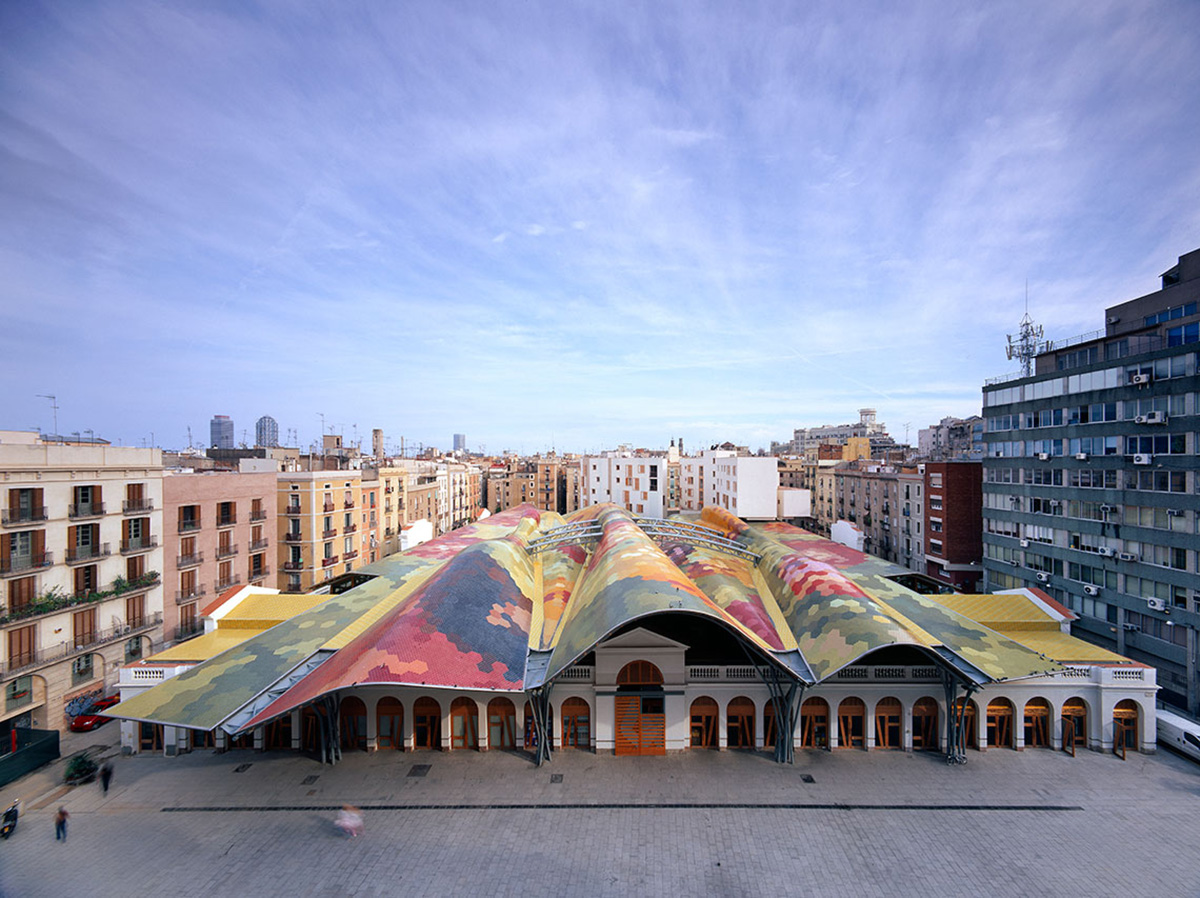
Santa Caterina Market in Barcelona. Image © Roland Halbe
Speaking to World Architecture Community in this fascinating interview, EMBT founder Benedetta Tagliabue also shares her thoughts about today's contemporary architecture. According to Tagliabue, architects started to be involved in more "thematical" worlds in architecture as the architecture started to explore itself in different disciplines and field of applications.
"I think now every architect is more involved into the thematical architecture like being sustainable for instance, or being conscious about using as less as possible the resources of our planet," she told World Architecture Community.
"They are also more conscious with the people who will use the place. I think, all of this brings us to the central point of architecture. Maybe it was not so clear ten years ago."
Tagliabue, 56, was born in Milan and she graduated from the Istituto Universitario di Architettura di Venezia in 1989. In the early 1990s, she married Spanish architect Enric Miralles and the pair founded their own studio Miralles Tagliabue EMBT.
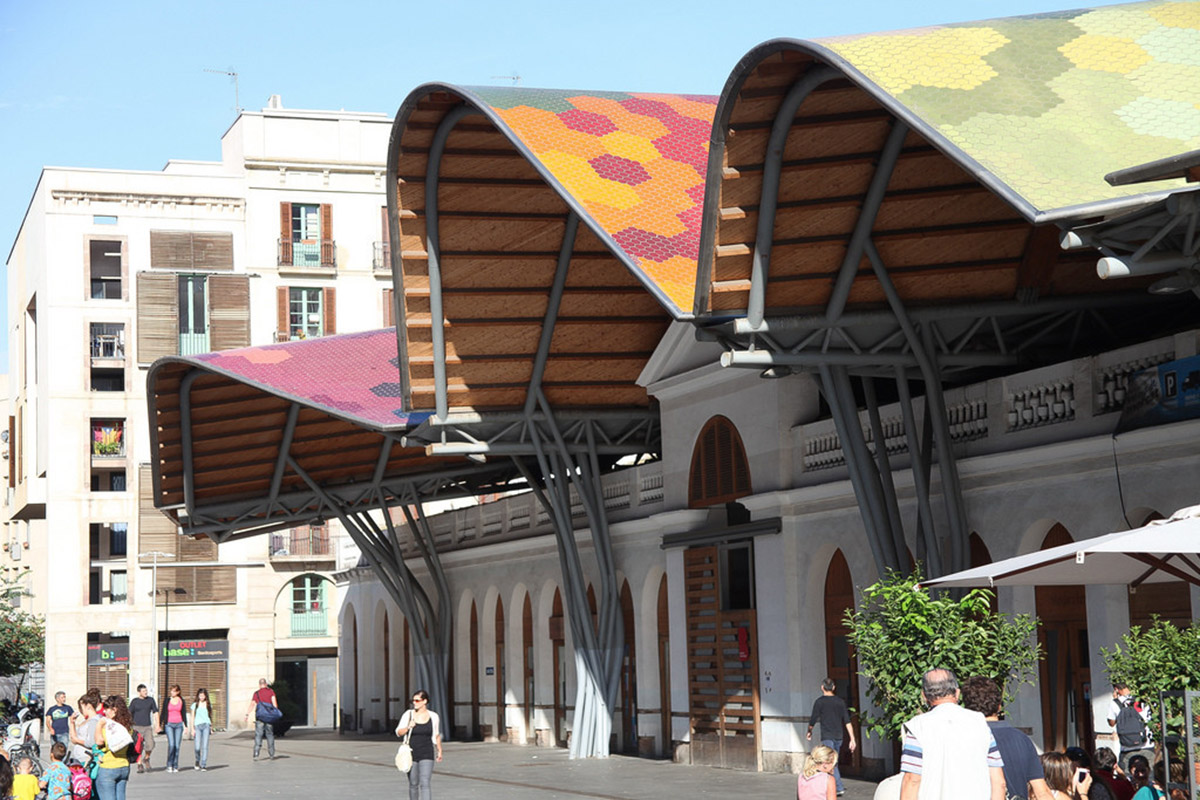
Santa Caterina Market. Image © Flickr user ligthelm licensed under CC BY 2.0
Together, Miralles and Tagliabue designed the practice's most notable works, including the renovation of the Santa Caterina Market in Barcelona and the enormous edifice of the Scottish Parliament Building, even architecture critic Charles Jencks had described it as "a kind of small city," reflecting the complexity and intricacy of the Edinburgh streets which it responds to.
In 2000, Tagliabue encountered Enric Miralles' tragic loss and she took over the firm as a sole director, completing the Santa Caterina market, Edinburgh Parliament and a string of other projects besides.
In recent years, the firm's most notable work has been the Spanish Pavilion completed for the 2010 Shanghai Expo, a design which delves into the studio's philosophy of continuing material experimentation and sustainability in material and handcrafts techniques.
Today, Tagliabue continues Enric Miralles' legacy and spirit in the Enric Miralles Foundation, established in 2011. The goal of the foundation is to promote experimental architecture to young generation architects in the spirit of her late husband and partner Enric Miralles.
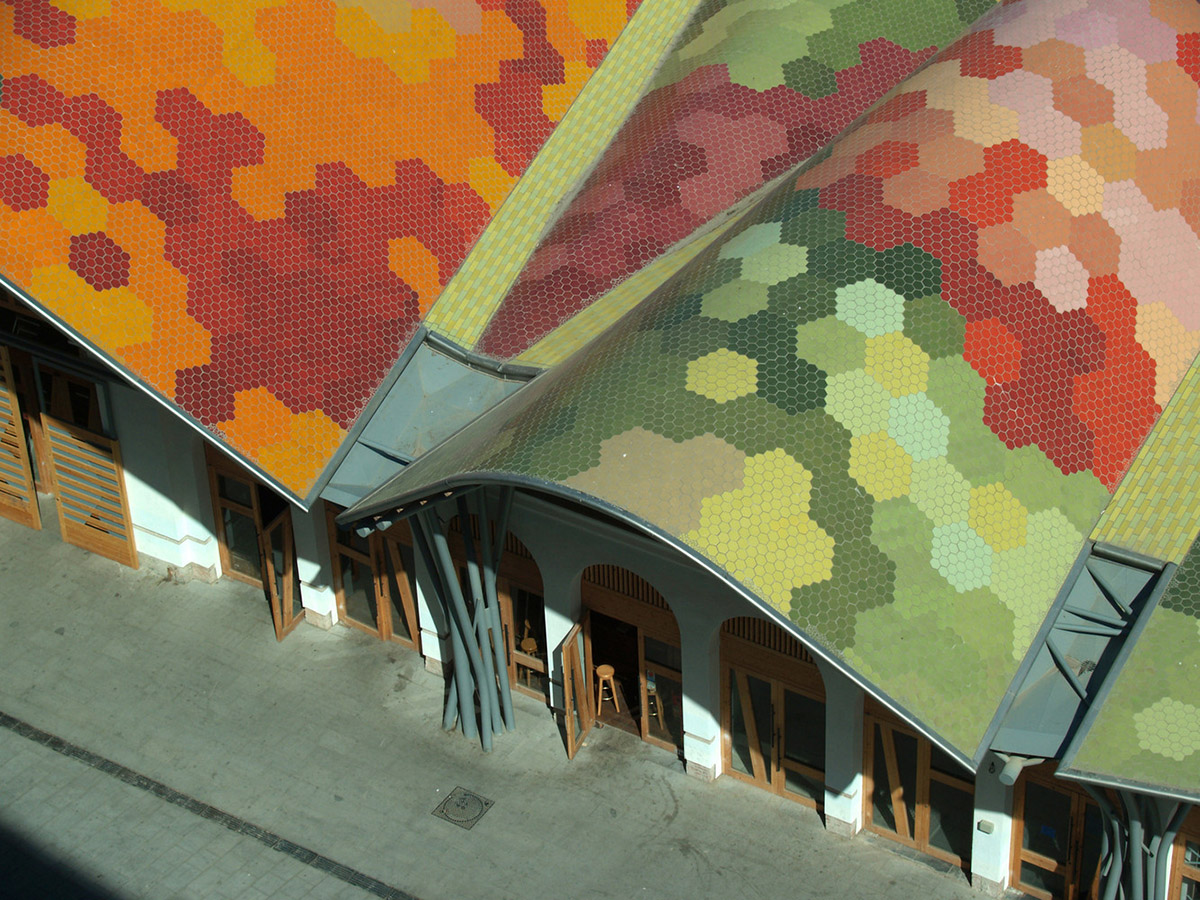
Santa Caterina Market. Image © Ceramica Cumella
"The mission of the foundation is to make everybody know the work of Enric Miralles and his spirit," said Tagliabue.
"In the way we inspire the young generation to do something which takes the inspiration of the work of Enric but evolves and go on."
"We like the Enric Miralles Foundation to be full with young architects, young students and to be full of enthusiasm and happiness and new experiment which was something that we love very much. It is a place where we like to discover new ways of doing architecture," she added.
Miralles Tagliabue EMBT has won international awards in the fields of public space and design, including the RIBA Stirling Prize in 2005, the National Spanish Prize in 2006, and the Catalan National Prize in 2002. Benedetta Tagliabue joined the Pritzker Prize jury in 2014.
The studio's current projects include the new Maggie's Center in Barcelona, Love It Pavilion for Expo Milano 2015, Castañer Store in Barcelona, Barajas Social Housing Blocks in Madrid, East Coast Restaurant in Hamburg.
Recently opened a branch studio in China, the firm is also working on a Sky Workshop – Youpon Integrated Ceiling Headquarter Campus Designer Village in Jiaxing, China, Vanke Hengbang C Tower in Xiamen, China, a campus of Fudan School Of Management in Shanghai, China, two major subway stations in Naples and Paris, as well as a church and a temple as spiritual projects. Her studio works in the fields of architecture, design of public spaces, rehabilitation, interior and industrial design.
In this exclusive interview, the architect Benedetta Tagliabue discusses EMBT's design philosophy, recent projects of the studio, her strong driven-forces on public spaces, and her experiences as a Pritzker Prize jury.
Read the full transcript of our interview with Benedetta Tagliabue below:
Berrin Chatzi Chousein: You established your firm Miralles Tagliabue EMBT with Enric Miralles in Barcelona. You have an extensive knowledge of the history of architecture and your focus is shifted in that way and reflected on your projects distinctively as a profound layer regarding the context. But could you please tell us about your background a little bit and the evolution of the studio? How did you start your practice?
Benedetta Tagliabue: We started our practice with Enric Miralles who was the young architect in Barcelona but he was always well known as he was very talented and youngest man. And for me, being a very young architect coming from Italy, I fell in love with this incredible young man and we decided to live together and to work together. Being together with Enric Miralles was working with him because work and life was one thing. Then we started to have a studio and to do projects which were about more dreams and utopias. We were travelling together and giving lectures in many different places and in the end we started to take projects which became more and more concrete. Later, we started to be a well known couple. I think this is our story and maybe the story of world of young practices.
Berrin Chatzi Chousein: You were born in Italy but you were educated there but you have been living and practicing in Spain for many years. How should we call you then? Italian or Spanish architect?
Benedetta Tagliabue: I also don’t know. I think I am travelling so much around and we are building in Germany, France, Netherlands, Italy, Taiwan, China – and I really don’t know - I think I’m a sort of person from many places and very open up to a new type of person of future which is all the national belonging to everywhere and nowhere.
Berrin Chatzi Chousein: Before moving into the pratice’s architectural approach, I would like to ask you, you have directed the office and produced a great number of projects together with Enric. Could you please tell us the way that you work together, how would you describe the relationship as a married couple in professional practice? Wasn't it hard to work together? I mean, did you have different roles in the studio? How did he influence you? (I’m asking this because leaving emotions behind professionalism can be difficult and you really have to be professionals while discussing on many serious issues for the projects).
Benedetta Tagliabue: I think it’s a kind of now-how issue because being a couple and private life also complement each other in profession. Especially in the architectural world – architecture is a kind of profession which is involving in every aspect of life. But in this sense, being a married couple and working together in the office is very nice in one aspect because you are sharing a project, you are sharing the desire to do the best together but at the same time it can be also so easy. You can also find yourself in talking the problems of the office or sometimes you have to find a kind of a way avoiding this. I think Enric was very special genious. He was very clever and very special and being a partner with him was very easy.
We developed a way compensating each other, of helping each other, and I didn’t really know how this was working until he died. And then I had to be myself and to go on in the office alone. From the moment Enric passed from my life, I discovered how many things I learned and how many things I had to share and I could still share even if he was not there.
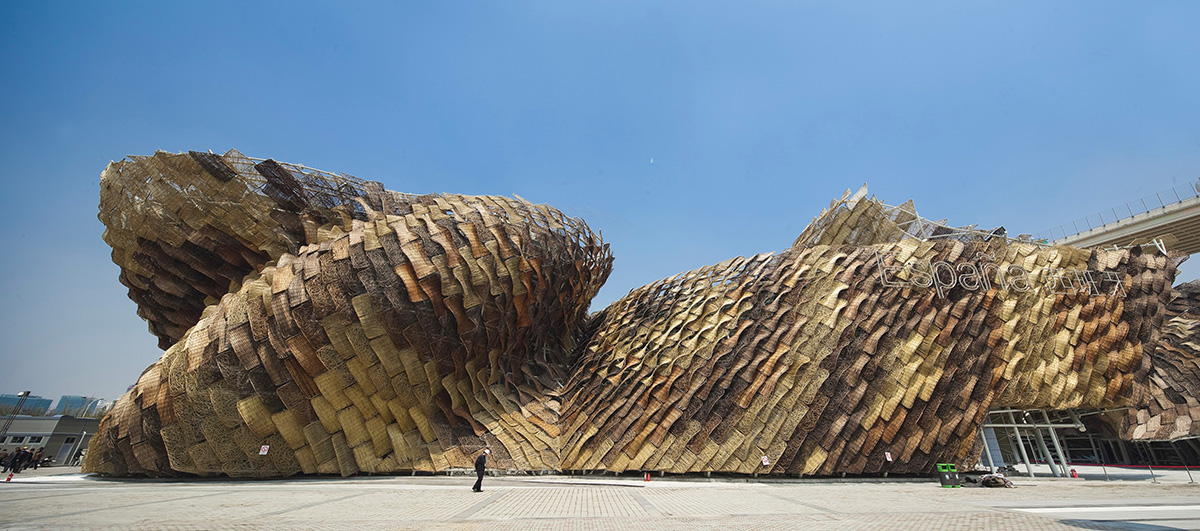
The Spanish Pavilion at the 2010 Shanghai Expo. Image © Shen Zhonghai/ KDE
Berrin Chatzi Chousein: How is the office evolving now after Enric? Did you make some radical changes in the ways you work?
Benedetta Tagliabue: I think it is evolving. I’m not sure about radical changes but many many things are happening now which were not happening before. For example, we started to work in the world of China and this was something that Enric couldn’t experiment and it’s something that I know very much. Also we are also involving to the world that is more natural type of architecture with natural materials and a great attention to technology and sustainability. I think at the time when I was working with Enric, this was not so evident. It was there but it was not so evident. I think things are developing and I like the ways develop little by little. We develop year by year. Now 19 years after Enric passed away, I think we have a more personal character of our office. We can understand it by looking at the projects we are doing.
Berrin Chatzi Chousein: You also established the Enric Miralles Foundation in 2011. Please tell us about the mission of the foundation. What does the foundation exactly do?
Benedetta Tagliabue: The mission of the foundation is tomake everybody know the work of Enric Miralles and his spirit. In the way we inspire the young generation to do something which takes the inspiration of the work of Enric but evolves and go on. So we like the Enric Miralles Foundation to be full with young architects, young students and to be full of enthusiasm and happiness and new experiment which was something that we love very much. It is a place where we like to discover new ways of doing architecture.
Berrin Chatzi Chousein: When I come back to the projects that you worked in the studio, I think there is a very characteristic approach and a very distinguished materialistic style on your projects. They are both formally strong and quite organic but also contextual (I think it is because of your deep knowledge of the history of architecture because they look like we see many layers of the history in your projects).
Could you please tell us about your architectural philosophy that you specifically pay attention to?
Benedetta Tagliabue: Well. It is very difficult to an architect to describe himself or herself. But I liked very much the words you have used with organic but at the same time structure. This is maybe something we like to do when we have designed new architecture but we also like very much to take inspiration from the site, from the situation and inspire ourselves to a specific situation that we find for a specific project. For example, we do large scale projects like a new piece of city, or sometimes we do projects like exhibitions or furniture and we like to do all of these but all of these with the same attention to the specific situation. So we like not to repeat in our work.
Berrin Chatzi Chousein: So you don’t believe in style, you mean.
Benedetta Tagliabue: In the end it is very difficult to avoid from the notion of style. I think you can recognize our way of doing architecture and sometimes we say that “this is the recipient of the house”. It is like when you enter the house, you can recognize the strong character of the house that belong to that people or family. In our work you can recognize it but we don’t call it as stylish.
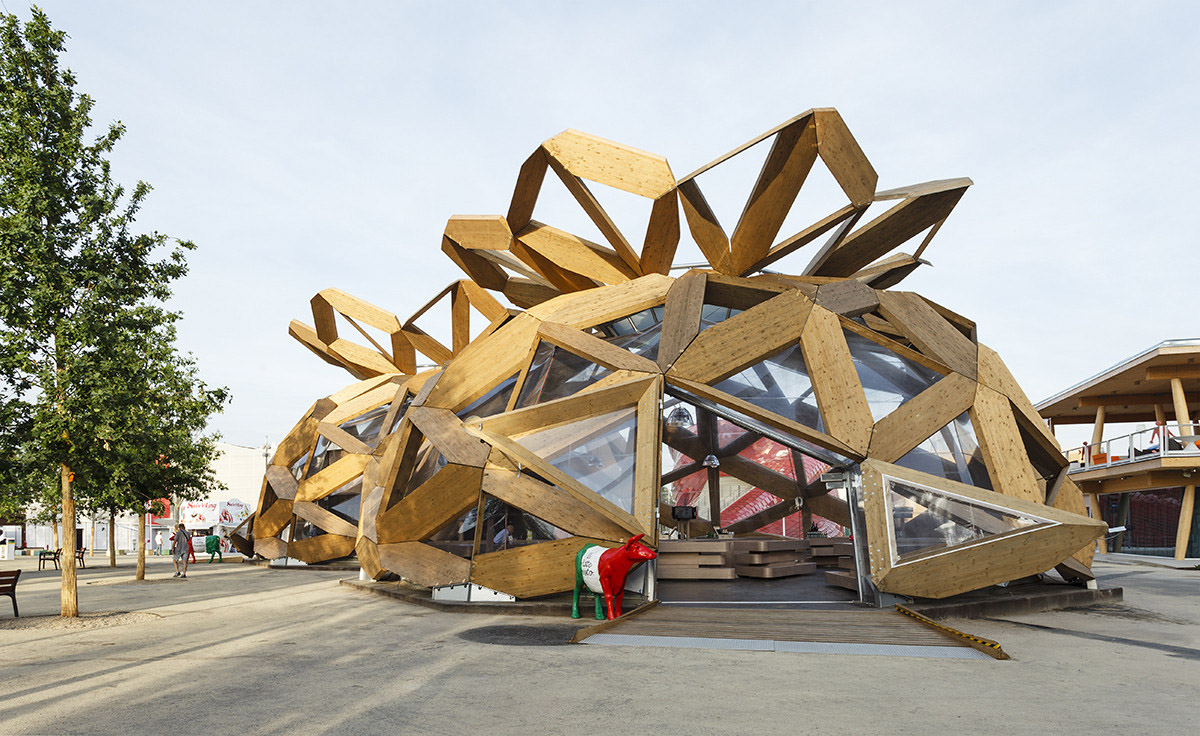
Copagri Pavilion "Love IT" for Expo Milano 2015. Image © Marcela Grassi
Berrin Chatzi Chousein: You are also using colours in your projects too much regardless of their scale and size. How would you describe the role ofcolor in your projects? For example, more specifically in Santa Caterina Market in Barcelona, Youth Music School in Hamburg, or in a public space Parc Dels Colors in Barcelona.
Benedetta Tagliabue: I think colors have fantastic possibilities. Sometime it seems that using colours in architecture was something like not acceptable. So little by little we started to discover how an architecture which is complete and drives to be natural or similar to the natural world and make people happier and we thought all these things can possible with colours. So we love colours as part of the reality and as part of the brought possibility of making architecture which is very open.And we would like to make feel people very comfortable. We love colours.
Berrin Chatzi Chousein: Your studio works in the fields of architecture, rehabilitation, interior and industrial design but also you design public spaces and I should say, it is quite strong to grasp a social value or social aspect of your projects because of their poeticalness. What are the most difficult things of creating a social value for public spaces in today’s architecture apart from their good, smart or technological infrastructure? What do you pay the most attention when creating public spaces? Because the public spaces should be working or should be alive for years over their instinct of possession.
Benedetta Tagliabue: It was easy for us to able to design public spaces because we were born in Spain, in the Spain of the 1980s and 1990s where a lot of public spaces and buildings were required. The public was increasing in that moment the way we didn’t have a lot of infrastructure and they had to be designed at that moment. So were able to participate in the public space competitions and we loved to be attentive to the population and to the social situations. We really believed that we should design for people and we should design to make the space better for the people who use them. So this was something natural coming from a specific time and a specific place in Spain. But I think little by little it is also going around the world.
We realize that you can also do it for health sector for a private company fo example, or do it for a school, or other type of clients. So we don’t limit ourselves to the public clients but we think that the public clients gave us a fantastic theme, or a fantastic place where to experiment our architecture. I think in the public projects the architects have difficulties of gaining benefit of money and have the difficulties of dealing with the administration. But you are really learning a lot and you can give the best of yourself. So I’m very proud of going on with our studio designing public projects.
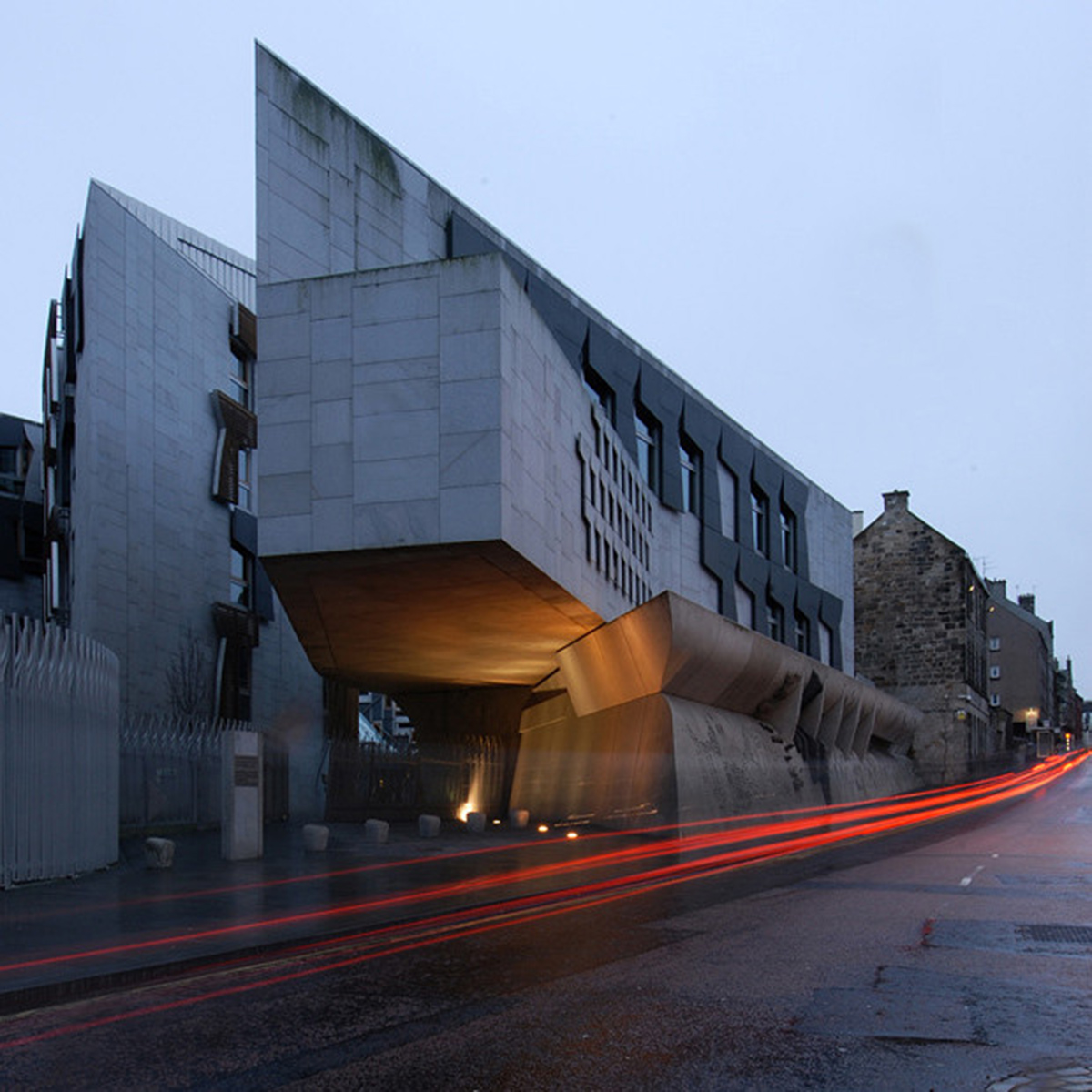
Scottish Parliament Building in Edinburgh, Scotland. Image © Dave Morris
Berrin Chatzi Chousein: Could you please tell us about your studio model now? Do you have a partner? Do you participate in all project discussions? Do you have other offices in other countries?
Benedetta Tagliabue: Yes, we have a branch office in China. I have partners and we have project directors. We are not a very big studio, we maintain ourselves in between 40-50 people. This is vey nice because we can still talk to each other, we can still interact in every project. I think the conversation is in our studio fluid. We have a kind of a system that is different than project director worked together with me. We have teams led by different project directors, I design together with the project directors and sometimes we try to involve in other project directors in the specific projects. So I would like the studio to be felt by everybody working there like a “collective place” where you don’t only look at your own project, also you can give a look to every other labelled project.
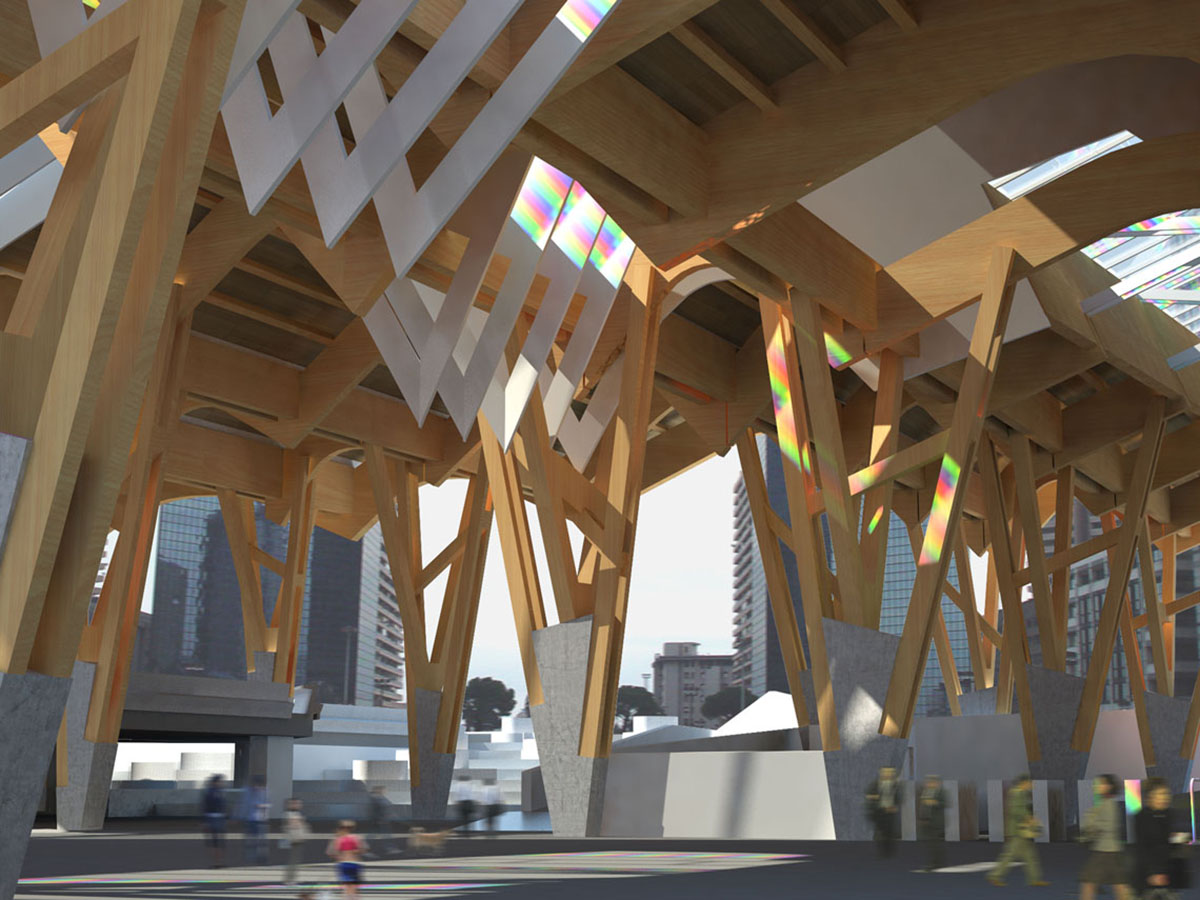
Naples Underground Central Station in Naples, Italy, which is one of the two subways stations that the studio is currently working on. Image courtesy of Miralles Tagliabue EMBT
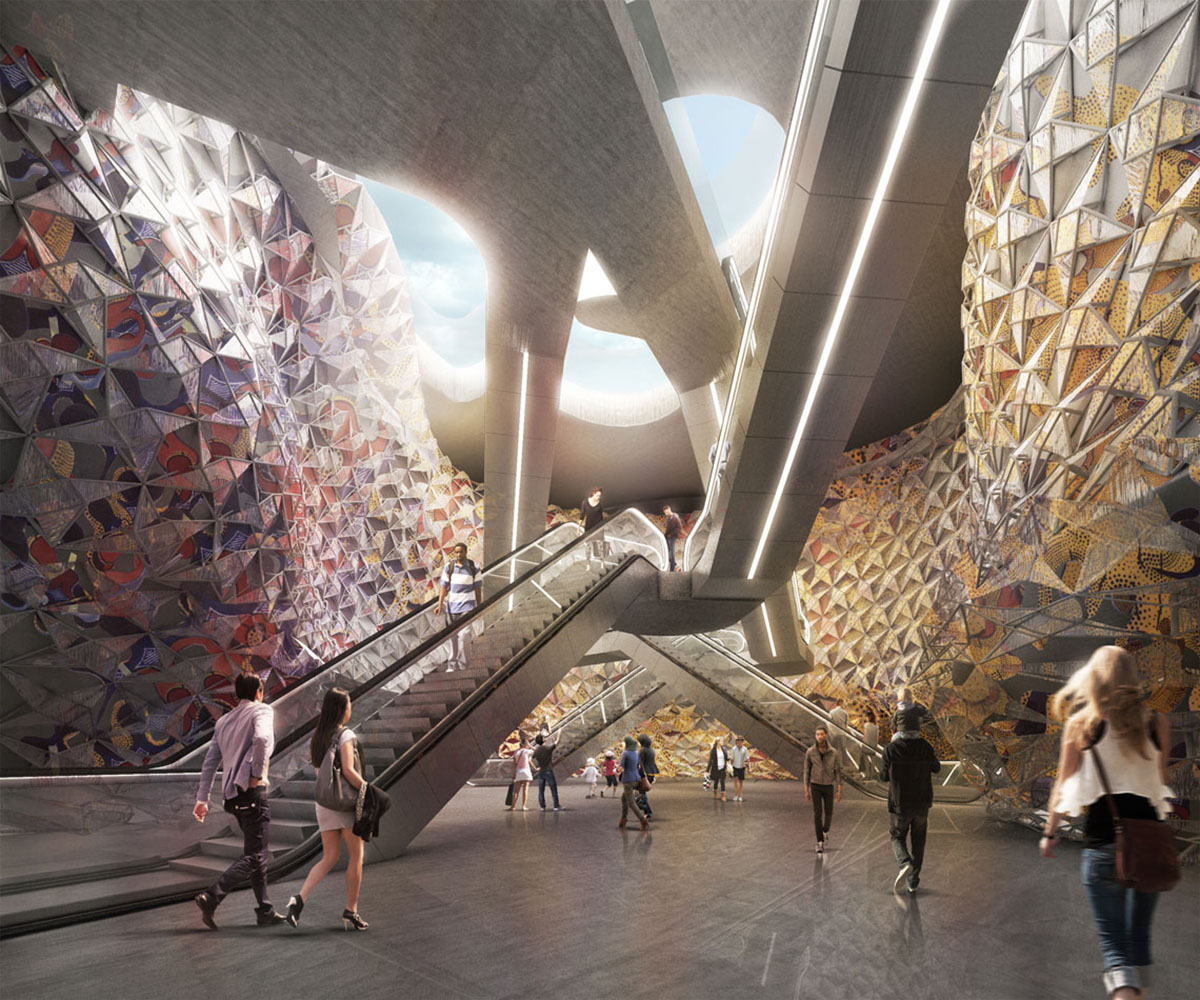
Clichy-Montfermeil Metro Station in Paris is one of the public projects of Miralles Tagliabue EMBT. Image courtesy of Miralles Tagliabue EMBT
Berrin Chatzi Chousein: Could you please tell us about recent projects? What are you currently working on?
Benedetta Tagliabue: Recently we have opened a very nice museum in Rome, which is very nice for me because it deals with the feeling of being Italian. I think it is really lovely to go back to a museum which is investigating being Italian. Our design was very much dealing with Italian monument, Italian churches, Italian copulas, Roman remains – I think it is very interesting. In addition, we have also designed a new Maggie’s Centre in Barcelona which is one of the first Maggie’s Centre outside of UK. The building is very lovely because it deals with health. We have been designing two subway stations – one in Naples and the other one in Paris. Both of these stations will create the public space better so these are very public projects. Also we work on other things and I think every project we do is very excited.
We are also working on some spiritual projects, for example, we are designing a church and a temple which comes from the buddhist tradition. I think it is really beautiful to participate to this spiritual buildings, because you really can do an architecture which is very complete.

Miralles Tagliabue EMBT completed new Maggie's Center in a UNESCO World Heritage site in Barcelona, Spain. Image © Lluc Miralles
Berrin Chatzi Chousein: You also joined in the Pritzker Prize jury in 2014. You are reviewing a large number of works and personalities serving the outstanding architecture. Could please tell us what are the urgent matters that you mostly pay attention to in the selection process personally? And, what is the difficult thing in selecting the most recognizable work during the selection process?
Benedetta Tagliabue: Now we are in an evolving momentand I think we have a very difficult situation than ten years ago. I think now every architect is more involved into the thematical architecture like being sustainable for instance, or being conscious about using as less as possible the resources of our planet. They are also more conscious with the people who will use the place. I think, all of this brings us to the central point of architecture. Maybe it was not so clear ten years ago.
So now as a jury, we have to try to be clever and to understand who and which work is complementing better these needs which are becoming soon important in humanity and architecture. So we are doing our best and it is not easy because as the Pritzker Prize involved in architecture all over the world. It is interesting, I think it is something like a process in which makes you learn a lot. It is a fantastic experience for me.
(-end of transcript)
Top image: Benedetta Tagliabue, image © Alejandro Quevedo
